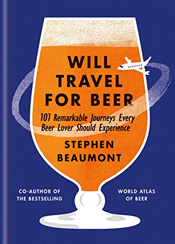In April, there was a link on Twitter to a news story about a “Bavarian ‘beer world'” that caused me to ask Stephen Beaumont and Mark Dredge, both of whom have recently written books about beer adventures, if they have been to Kuchlbauer’s Bierwelt.
Dredge responded first, “I drove near it when going to drink zoigl but decided not to stop there!”
And Beaumont followed, “Can’t say I’ve ever been or, having read the article, are inclined to go. Animatronic beer gnomes?”
Not long after, Joe Stange — who lives in Berlin — added, “Kuchlbauer… The beer is fine but Hundertwasser is the real attraction.” Hundertwasser is the tower within the park.
All three of these men spell flavour with a u, but they’ve earned my trust and their most recent books merit attention. That Beaumont and Dredge have written ones called Will Travel for Beer and The Beer Bucket List respectively is something of a coincidence that illustrates it must be time for such a travel books (or books), along the lines one of those one hundred and one or one thousand and one before you die titles. That this is the eight edition of Good Beer Guide Belgium, which Stange co-wrote with Tim Webb, since 1992 points to a dynamic that isn’t just about Belgium.
 (This is probably a good spot for a disclaimer. My name appears in the credits for both Beaumont and Dredge’s books. Stange and I most recently drank beers together in May, and Webb wrote the foreword for Brew Like a Monk. This post is not intended as a critical review, but to a) inform readers about these books or b) perhaps earn something like 12 cents from Amazon if you click on a link to buy a book. Commerce at its best.)
(This is probably a good spot for a disclaimer. My name appears in the credits for both Beaumont and Dredge’s books. Stange and I most recently drank beers together in May, and Webb wrote the foreword for Brew Like a Monk. This post is not intended as a critical review, but to a) inform readers about these books or b) perhaps earn something like 12 cents from Amazon if you click on a link to buy a book. Commerce at its best.)
GBGB No. 8 lists more breweries than No. 7, growing from 160 to 245, and more cafes (500 to 800). That’s a lot of changes. Webb, who wrote the first of this on his own, or as “on his own” as any such book exists, explains early on that the book was conceived in a bar late at night, in fact Brugs Bertje in Bruges, in 1987 or 1988. It was intended to be a pamphlet. “A quarter of a century later it feels more like a religious text, curated by chosen protectors of the faith, telling you want to think but hopefully explaining why you should think,” he writes. This will be his last, and he wishes the guide “the wisdom to judge fairly, and the strength to remain unbending.”
Stange does not bend easily, and it often seems as if they write with one voice. Even when the news is a bit sad. For instance, Caracole, which has a delightful wood-fired brewhouse, receives high enough marks for the beers it was making when I visited more than a dozen years ago, but they write, “beers bearing the Bio mark can be problematic and a recent run of beers infused with various essences is best forgotten.” Sigh.
 GBGB best serves readers with a destination in mind. The Beer Bucket List and Will Travel for Beer begin by suggesting destinations. I am reminded by a list of reasons to travel Evan Rail provides in Why We Fly (although he writes his experience is different): “A common reason to travel is personal experience. We travel to taste something new or find someone new, to drink or to eat, to feel or to touch or be touched. We travel to let ourselves go, or to go find ourselves. Whether the experience is spiritual or mundane, it is the desire for experience that gives us the most obvious justification to transport our bodies around this planet.”
GBGB best serves readers with a destination in mind. The Beer Bucket List and Will Travel for Beer begin by suggesting destinations. I am reminded by a list of reasons to travel Evan Rail provides in Why We Fly (although he writes his experience is different): “A common reason to travel is personal experience. We travel to taste something new or find someone new, to drink or to eat, to feel or to touch or be touched. We travel to let ourselves go, or to go find ourselves. Whether the experience is spiritual or mundane, it is the desire for experience that gives us the most obvious justification to transport our bodies around this planet.”
Both Beaumont and Dredge provide practical tips as well as basics such as addresses, but both books are at their best when the authors let themselves go.
First, Beaumont:
 “When I was in Finland, I was invited to partake of a ‘smoke sauna’, that being a sauna heated by wood fire in a stove with no chimney. Perhaps it was merely the experience of being in the right place at the right time, or maybe it really is my personal preference, but it is the only sort of sauna I have every truly enjoyed. Mind you, that beer probably helped, too.
“When I was in Finland, I was invited to partake of a ‘smoke sauna’, that being a sauna heated by wood fire in a stove with no chimney. Perhaps it was merely the experience of being in the right place at the right time, or maybe it really is my personal preference, but it is the only sort of sauna I have every truly enjoyed. Mind you, that beer probably helped, too.
“The process went like this: strip down; enter hot sauna; sit and sweat; exit sauna; drink sahti from a communal harrikka (the classic two-handled, pail like mug made from juniper wood); repeat. … After following this order two or three times, I was ready to add a step, that being a quick dip in the nearby lake — entered via a hole cut through the ice cover.”
Now, Dredge from the Blumenau Oktoberfest in Brazil:
 “As I stood in the sweaty heat, drinking local Pilsners, repeatedly and drunkenly shouting something like “Zicke Zaeke, Zicke Zaeke, Oi! Oi! Oi!” and watching people get off with each other, I could help but laugh. This is one of the most surreal and wonderful and unexpected world beer festivals in a town that looke like a scaled-up version of a South German toy town. Blumenau’s Oktoberfest is not the easiest or cheapest beer event to get to; it’s not the best beer festival either, and you probably won’t find the greatest beer you’ve ever drunk, but you will experience something totally unique.”
“As I stood in the sweaty heat, drinking local Pilsners, repeatedly and drunkenly shouting something like “Zicke Zaeke, Zicke Zaeke, Oi! Oi! Oi!” and watching people get off with each other, I could help but laugh. This is one of the most surreal and wonderful and unexpected world beer festivals in a town that looke like a scaled-up version of a South German toy town. Blumenau’s Oktoberfest is not the easiest or cheapest beer event to get to; it’s not the best beer festival either, and you probably won’t find the greatest beer you’ve ever drunk, but you will experience something totally unique.”
Both Dredge and Beaumont included Blumenau in their book, and as you would expect many destinations end up in both. Yet neither drank Gose in Leipzig, Grodziskie in Grodzisk or chicha in the Sacred Valley, although Dredge writes about the extensively about the last because it remains on his list. He and I had a few historic lagers together in April at Urban Chestnut’s LagerFest. He’s at work on a book about lager and scheduled a trip to visit several US lager breweries around the event.
“It was hard sometimes to look at things and think that it’s not bucket list level,” he said. “The fun part was working out what was really the most interesting in the world.”
Myself, I still can’t believe Hundertwasser and the Straub Brewery Eternal Tap didn’t make the cut.
We visited Kuchlbauer but only because the Hofbräu Abensberg was undergoing renovations and we never could find the tap room for Ottenbräu (we did find the brewery and the old tap room). We needed a beer.